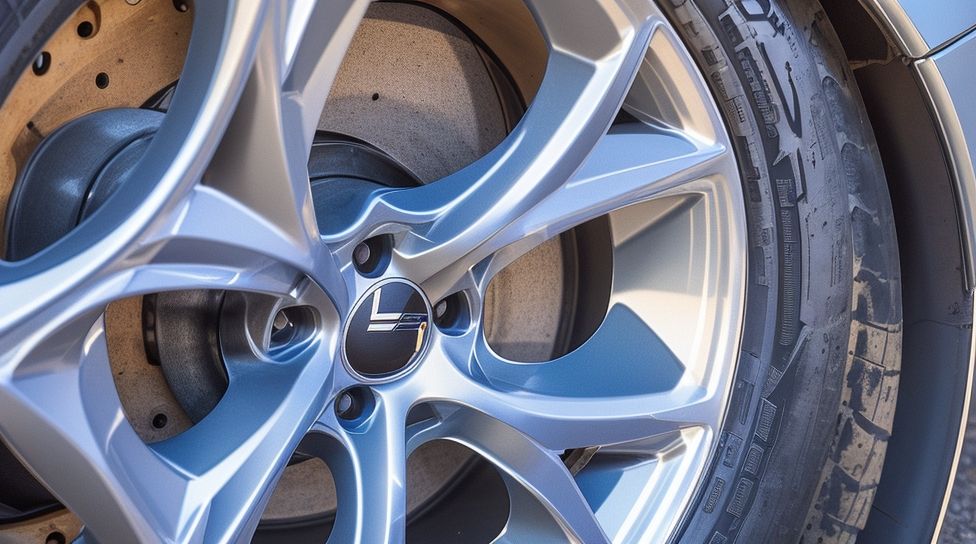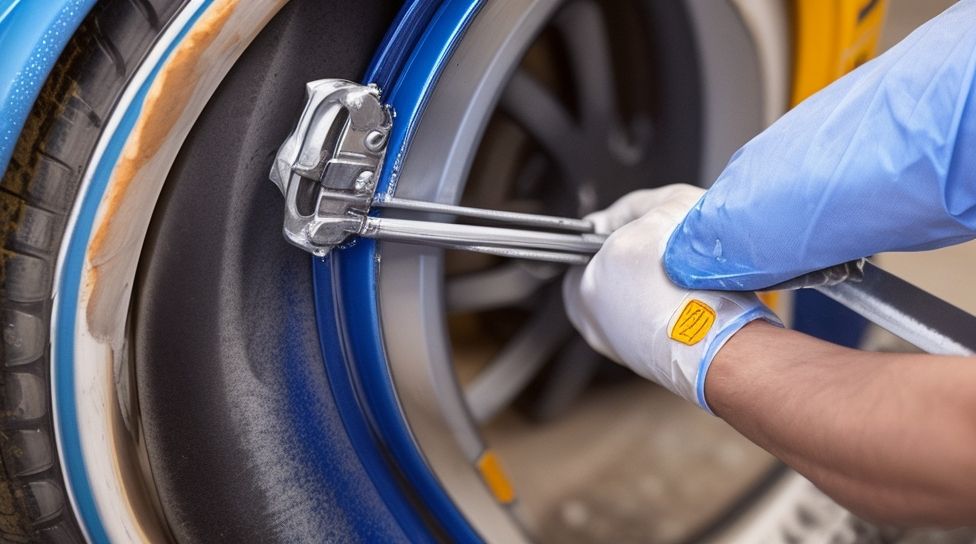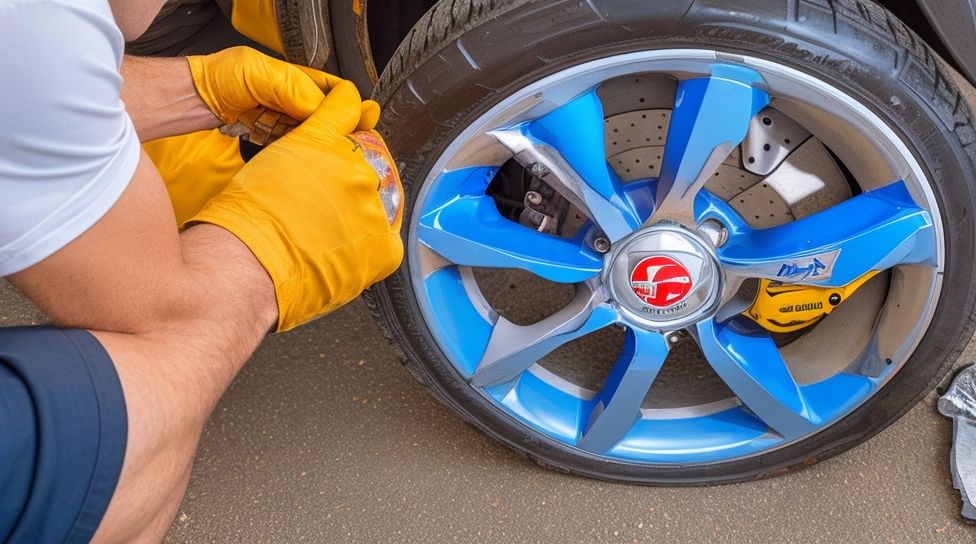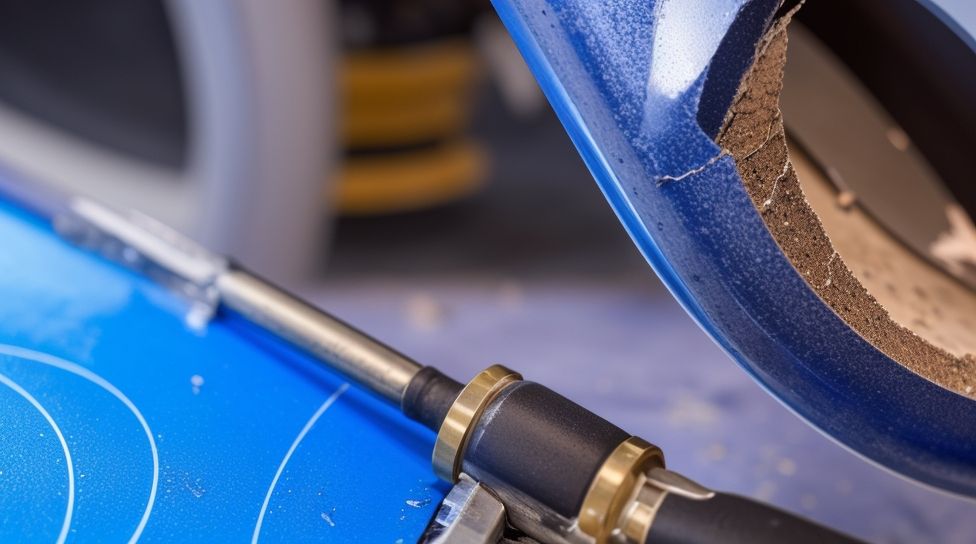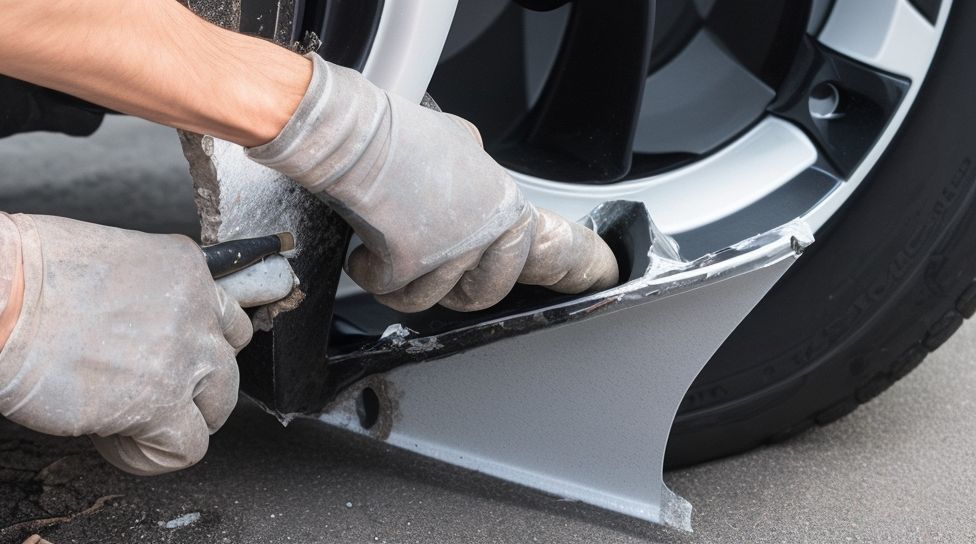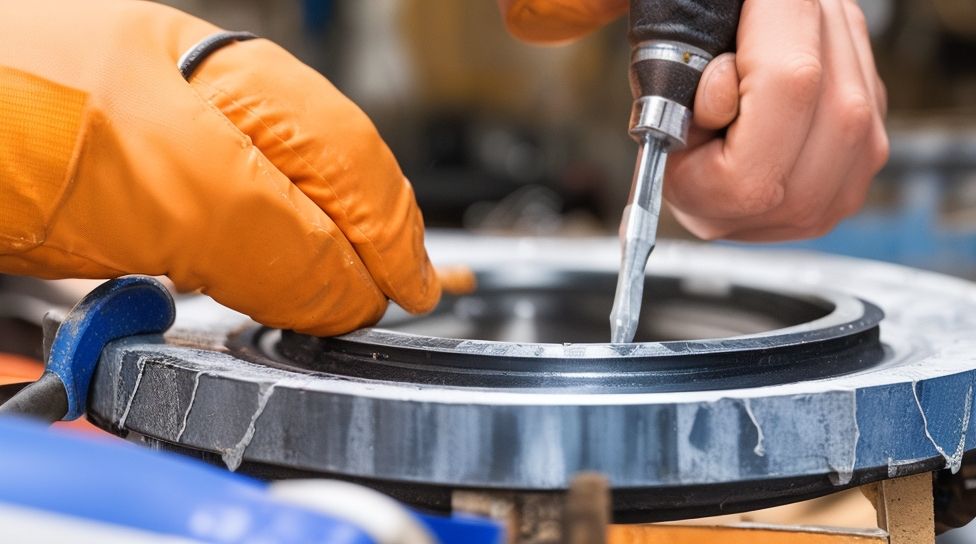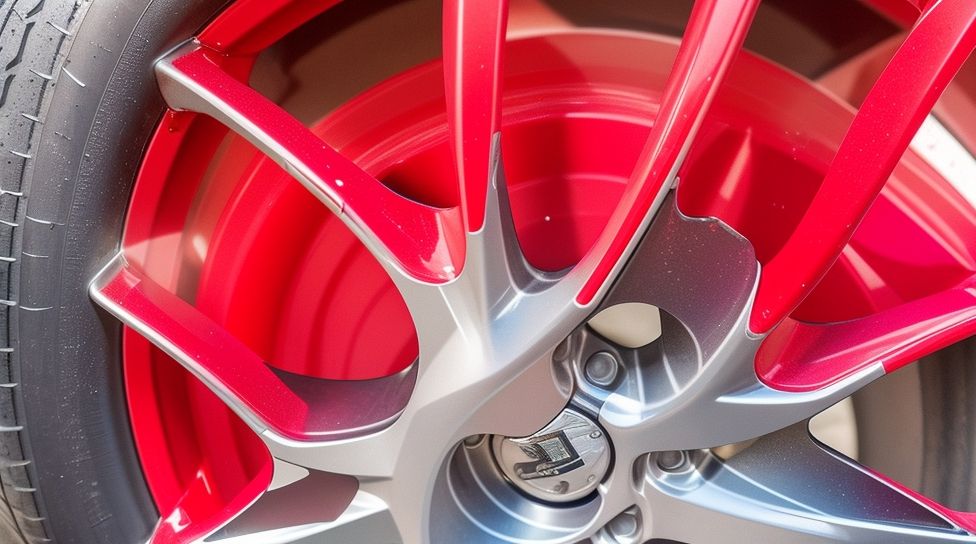
Rim cracks can be a common issue for vehicle owners, and knowing how to fix them can save you time and money. While seeking professional help is usually recommended for this type of repair, there are some instances where fixing a cracked rim at home is possible. However, it’s important to understand the nature and severity of rim cracks before attempting any repairs.
Understanding Rim Cracks:
Rim cracks are structural damages that occur on the wheel rims of vehicles. These cracks can be caused by various factors, including potholes, collisions, or over-tightening lug nuts. They can vary in size and location, ranging from small hairline cracks to larger, more severe fractures.
Assessing the Damage:
Before attempting to repair a cracked rim at home, it is crucial to assess the damage properly. This involves identifying the cracks and determining their type, as different cracks may require different repair methods.
Fixing a Cracked Rim at Home: Step-by-Step Guide:
Fixing a cracked rim at home can be a temporary solution to get your vehicle back on the road, but it should be approached with caution. The process involves gathering the necessary tools and materials, preparing the rim for repair, and carrying out the actual repair. It’s important to note that this guide focuses on repairing small rim cracks, as larger cracks may require professional intervention.
When to Seek Professional Help:
While fixing a cracked rim at home may seem cost-effective, it’s essential to know when to seek professional help. Signs that rim replacement is necessary include severe and extensive cracks, visible distortion or bending of the rim, or if the cracks reappear after attempted repairs.
Tips to Prevent Rim Cracks:
Prevention is always better than cure when it comes to rim cracks. Proper tire and rim maintenance, such as regular inspections and correct tire inflation, can help prevent cracks from developing. Adopting driving habits that avoid excessive impacts and avoiding harsh conditions can help protect your rims from potential damage.
Key takeaway:
- Understanding Rim Cracks:
- Rim cracks can be caused by various factors and it is important to understand their severity.
- Assessing the damage:
- Learn how to identify rim cracks and the different types that exist.
- Fixing a Cracked Rim at Home:
- Follow a step-by-step guide and gather the necessary tools and materials to repair small and large rim cracks.
Understanding Rim Cracks
Photo Credits: Www.Smarthousemagic.Com by Logan Jones
Before attempting to fix a cracked rim at home, it is important to understand the nature of rim cracks:
Types of Rim Cracks:
- Radial Cracks: These cracks extend from the center of the rim towards the outer edge in a straight line.
- Lateral Cracks: Lateral cracks run along the circumference of the rim, parallel to the edge.
- Spiderweb Cracks: Spiderweb cracks are a network of small cracks that form a pattern resembling a spider’s web.
- Impact-Related Cracks: These cracks occur as a result of an impact, such as hitting a pothole or curb. They can be radial, lateral, or spiderweb in nature.
Causes of Rim Cracks:
- Potholes and Road Hazards: Hitting potholes, speed bumps, or other road hazards can cause excessive stress on the rim, leading to cracks.
- Overloading: Carrying a heavier load than the rim’s weight capacity can cause structural damage and cracks.
- Corrosion: Rust or corrosion weakens the rim’s integrity, making it more prone to cracking.
- Tire Pressure Issues: Insufficient tire pressure or overinflation can cause the rim to bear excessive stress, leading to cracks.
- Manufacturing Defects: In some cases, rim cracks may be a result of manufacturing defects or material weaknesses.
Assessing Rim Cracks:
It is crucial to carefully assess the severity and location of the rim cracks. Superficial or minor cracks may be repairable, while extensive or structural cracks may require professional assistance or rim replacement. It is generally recommended to consult a qualified tire and rim specialist for a proper evaluation.
Note: Attempting to fix a cracked rim at home may not always be safe or effective, as it requires specialized tools, skills, and knowledge. It is advisable to seek professional help for proper repairs or replacement to ensure the safety and reliability of your vehicle.
What Causes Rim Cracks?
Rim cracks can be a common issue for car owners, so it’s important to understand What Causes Rim Cracks? This understanding is vital in preventing costly damage and maintaining the safety and functionality of your vehicle.
One major cause of rim cracks is hitting a pothole or other road hazards. When the tire forcefully hits a pothole, the impact can transfer to the rim and result in cracks. This risk becomes even higher if the tire is underinflated since it provides less protection against impact.
Another cause of rim cracks is colliding with a curb or other solid objects while driving. Even a minor collision can lead to damage and eventually cracks in the rim. To avoid this, it’s crucial to be cautious when parking or maneuvering your vehicle to minimize contact with curbs or other obstacles.
Rim cracks can also occur as a result of metal fatigue. Over time, the constant stress and strain on the rim can weaken it, making it more susceptible to cracking. This is especially true if the vehicle is regularly driven in harsh conditions or on rough terrain.
It’s worth noting that rim cracks may also be caused by manufacturing defects or the use of poor quality materials. In such cases, cracks may appear even with normal usage and proper maintenance.
To prevent rim cracks, practicing proper tire and rim maintenance is crucial. Regularly checking tire pressure and ensuring it remains at the recommended level can help reduce the risk of cracks. Additionally, rotating tires regularly can distribute the load evenly, preventing excessive stress on one area of the rim.
Moreover, driving cautiously and avoiding aggressive maneuvers or rough driving conditions is essential. By being mindful of road hazards and maintaining a safe distance from curbs and other obstacles, you can effectively minimize the risk of rim cracks.
How Serious Are Rim Cracks?
Rim cracks may seem like a minor issue, but how serious are rim cracks? They can have serious implications for your vehicle’s safety and performance. Understanding the severity of rim cracks is crucial in deciding how to address the problem. Here are some key points to consider:
1. Rim cracks can compromise the structural integrity of your wheel. Even small cracks can lead to further damage over time, such as air leakage or wheel failure. It is important not to underestimate the potential risks associated with rim cracks.
2. The seriousness of rim cracks depends on their location, size, and depth. Cracks near the spokes or the mounting surface are more concerning than those on the outer edge of the rim. Larger and deeper cracks pose a higher risk as they are more likely to worsen and cause tire damage.
3. Rim cracks can affect tire performance. As the cracks widen, they can cause tire pressure loss and lead to uneven wear. This can impact your vehicle’s handling, stability, and fuel efficiency. Driving with a damaged rim increases the risk of a tire blowout.
4. Rim cracks can be a symptom of underlying issues. Wheel impacts, potholes, or improper tire mounting can contribute to rim cracks. It’s important to inspect your rims regularly and address any cracks promptly to prevent further damage.
5. Professional assessment is crucial for accurate diagnosis. While you can visually inspect your rims for cracks, it is recommended to have them evaluated by a professional. They can provide a detailed assessment, determine the severity of the cracks, and recommend the best course of action.
It is essential not to overlook rim cracks as they can have serious consequences for your vehicle’s safety and performance. If you notice any signs of cracking, have your rims inspected by a professional to ensure proper maintenance and to avoid potential hazards on the road.
True story: John, a diligent driver, noticed a small crack on his rim after hitting a pothole. Although it appeared minor at first, John decided to have it checked by a mechanic. To his surprise, the crack was deeper than it seemed, and the mechanic advised replacing the rim immediately. Thanks to his quick action and professional assessment, John avoided potential tire damage and ensured his safety on the road. Remember, even seemingly insignificant rim cracks can have serious implications, so it’s better to be safe than sorry.
If you think assessing the damage on your cracked rim sounds like a fun activity, you probably have a dark sense of humor, and I like you.
Assessing the Damage
Photo Credits: Www.Smarthousemagic.Com by Eugene White
When it comes to fixing a cracked rim at home, the first step is to assess the damage to determine if it is repairable or if professional assistance is required. Here are the key points to consider:
- Visual Inspection: Carefully examine the cracked rim to assess the extent of the damage. Look for visible cracks, bends, or deformations in the rim structure.
- Size and Location: Note the size and location of the crack on the rim. Small cracks in non-stressed areas may be repairable, while larger cracks or those in critical areas may require professional attention.
- Depth of the Crack: Determine the depth of the crack. Surface-level cracks may be fixable, but deep cracks that compromise the structural integrity of the rim may necessitate replacement.
- Additional Damage: Check for any additional damage to the rim, such as dents or bends. Multiple issues can affect the repairability of the rim.
- Tire Condition: Inspect the tire mounted on the rim for any signs of damage or stress. A cracked rim can impact tire performance and safety, so it’s important to assess the tire’s condition as well.
- Personal Skill and Equipment: Evaluate your own skill level and the equipment available to you. Repairing a cracked rim requires technical expertise and specialized tools. If you lack experience or necessary resources, it may be safer to seek professional help.
- Safety Considerations: Consider safety implications. A cracked rim can compromise the structural integrity of the wheel, leading to potential failure while driving. If there are doubts about safety or the ability to properly repair the rim, it is advisable to consult a professional.
By assessing the damage and considering these factors, you can make an informed decision on whether to proceed with repairing the cracked rim at home or seek professional assistance to ensure the safety and performance of your vehicle.
How to Identify Rim Cracks?
To identify rim cracks, here’s what you need to do:
1. Visual inspection: Carefully examine the entire surface of the rim, both inner and outer edges, for any visible cracks or fractures.
2. Check for deformities: Run your hand along the rim’s surface to detect any irregularities or deformities. Sometimes, cracks can cause the rim to appear uneven or misshapen.
3. Listen for unusual sounds: Gently tap the rim with a rubber mallet or similar tool while listening for any unusual sounds. Cracks can create a distinct hollow or metallic sound compared to a solid rim.
4. Perform tactile examination: Use your fingertips to feel for any inconsistencies or roughness on the rim. Cracks can often be detected through touch, as they may create a noticeable gap or rough edge.
5. Utilize a dye penetrant: Apply a specialized rim crack detection fluid, such as a dye penetrant, to the rim’s surface. After a few minutes, wipe away the excess fluid. If there are any cracks, the penetrant will seep into them, highlighting their presence.
6. Inspect for air leakage: Inflate the tire and spray a soapy water solution onto the rim’s surface. If there are any cracks, bubbles will form, indicating air leakage through the cracks.
7. Seek professional help: If you are uncertain about the presence or seriousness of rim cracks, it is advisable to consult a professional. They possess the expertise and specialized tools to accurately diagnose rim cracks and suggest appropriate solutions.
It’s important to remember that identifying rim cracks is crucial for your vehicle’s safety. If you discover any cracks, it is essential to address them promptly to prevent further damage and potential accidents on the road.
Types of Rim Cracks
- There are various types of rim cracks, including impact cracks, heat cracks, corrosion cracks, manufacturing defects, and fatigue cracks.
- Impact cracks occur when the rim experiences a sudden and forceful impact, such as hitting a pothole or curb. These cracks are typically characterized by a single crack line radiating from the point of impact.
- Heat cracks are caused by excessive heat buildup in the rim, often due to prolonged heavy braking or aggressive driving. These cracks usually appear as hairline fractures on the surface of the rim.
- Corrosion cracks develop over time as a result of exposure to moisture and corrosive substances such as road salt. These cracks are typically seen in older rims and are characterized by a jagged or irregular appearance.
- Some rim cracks can be attributed to manufacturing defects, such as weak spots or inconsistencies in the material. These cracks may appear anywhere on the rim and can vary in severity.
- Fatigue cracks occur when the rim undergoes repetitive stress or loading, causing gradual weakening of the material. These cracks often form around the bolt holes or spoke attachment points and may spread over time.
Fact: Approximately 30% of rim cracks are the result of impact damage caused by hitting potholes or curbs.
Don’t crack under pressure, fix that rim like a pro with this step-by-step guide.
Fixing a Cracked Rim at Home: Step-by-Step Guide
Photo Credits: Www.Smarthousemagic.Com by Bradley Williams
Fixing a cracked rim at home may sound daunting, but fear not! In this step-by-step guide, we’ll walk you through the process of repairing your cracked rim. From gathering the necessary tools and materials to preparing the rim for repair, we’ve got you covered. Whether you’re dealing with small rim cracks or larger ones, we’ll provide the guidance you need to get your rims looking as good as new. So grab your tools and let’s dive in!
Gather the Necessary Tools and Materials
- When it comes to fixing a cracked rim at home, it is essential to gather all the necessary tools and materials beforehand. By doing so, you can ensure a smooth and efficient repair process. Here’s a step-by-step guide on how to gather the required tools and materials:
- Wheel jack: To lift the vehicle off the ground and remove the damaged rim, a wheel jack is indispensable. Ensure that you select a jack suitable for your vehicle’s weight.
- Lug wrench: A lug wrench is a must-have tool for loosening the lug nuts that secure the rim to the wheel hub.
- Spare tire: It is crucial to keep a spare tire on hand in case you need to temporarily replace the damaged rim.
- Tire iron: Along with the lug wrench, a tire iron is used to remove the lug nuts. It provides additional leverage for loosening tight lug nuts.
- Tire repair kit: A tire repair kit is equipped with essential items like a tire plug, rubber cement, and a tire pressure gauge. These tools will prove beneficial if the tire itself is damaged.
- Rubber mallet: A rubber mallet is handy for gently tapping the rim back into place or dealing with stubborn lug nuts.
- Wire brush: To clean the rim and eliminate any debris or rust that may be present, a wire brush is employed.
- Air compressor: An air compressor becomes necessary for inflating the tire to the recommended pressure once the repair is complete.
- Protective gloves: Wearing protective gloves is crucial to prevent any injuries or damage to your hands during the repair process.
- Safety glasses: Safety glasses provide essential eye protection while working on the rim, preventing any potential harm from debris or particles.
Fact: Were you aware that regular tire and rim maintenance can extend their lifespan and reduce the risk of cracks or damage? Conducting frequent inspections, maintaining proper tire inflation, and avoiding rough driving conditions can significantly contribute to preventing rim cracks.
Is your rim cracked? Don’t worry, we’ll prepare it for repair and make it road-worthy again.
Preparing the Rim for Repair
Preparing the Rim for Repair
- Before starting the repair process, it is essential to thoroughly inspect the rim for any visible damage or cracks. This step is crucial in determining the extent of the repair needed for the rim.
- To ensure a clean working surface for the repair, use a hose or pressure washer to clean the rim and remove any dirt, grime, or debris that may be present.
- In order to have better access to the damaged area, carefully remove the tire if it is still mounted on the rim before proceeding with the repair.
- Smooth out the damaged area of the rim using sandpaper or a sanding block. This step aids in creating a clean surface that the repair materials can adhere to effectively.
- Apply a primer specifically designed for rim repairs to the damaged area. This particular step improves the adhesion of the repair materials and serves to prevent any further damage.
- Follow the manufacturer’s instructions to mix the repair materials properly. Typically, this involves combining a base material with a hardener, resulting in a strong and durable repair solution.
- Using a putty knife or a similar tool, apply the repair materials to the damaged area, ensuring that it covers the entire damaged area and is smoothed out for a seamless repair.
- Allow sufficient time for the repair materials to cure after their application. To determine the recommended curing time, refer to the manufacturer’s instructions.
- Once the repair materials have cured, sand the repaired area to achieve a smooth finish. This step helps in blending the repair with the rest of the rim surface.
- Depending on the type of rim and the desired aesthetic, you can choose to paint or coat the entire rim. This additional step further protects the repaired area and enhances its overall appearance.
Fact: Properly preparing the rim for repair is crucial to ensure a strong and long-lasting fix. Thoroughly inspecting, cleaning, and smoothing the damaged area allows for an optimal surface for the repair materials. This, in turn, results in a seamless and effective repair.
Fixing small rim cracks is like giving your car a Band-Aid – it might not be the most permanent solution, but it gets the job done.
Repairing Small Rim Cracks
- When it comes to repairing small rim cracks, following a step-by-step process can help you fix the issue effectively. Here are the essential steps to repairing small rim cracks:
- Inspect the rim: Begin by thoroughly examining the rim to identify the location and extent of the crack. This will help determine the appropriate repair method for repairing small rim cracks.
- Clean the area: Clean the cracked area of the rim using a mild detergent and water. Ensure that it is free from dust, dirt, and any other debris that could interfere with the repair process of small rim cracks.
- Prepare the repair materials for small rim cracks: Gather the necessary tools and materials for the repairing small rim cracks, such as epoxy adhesive, sandpaper, and a clean cloth. Make sure you have everything within reach before proceeding.
- Sand the cracked area: Use sandpaper to roughen the surface around the crack. This will create a better bonding surface for the epoxy adhesive when repairing small rim cracks effectively.
- Apply epoxy adhesive: Carefully apply the epoxy adhesive to the cracked area, making sure to cover the entire length of the crack. Use a clean cloth to remove any excess adhesive when repairing small rim cracks with epoxy adhesive.
- Let it dry: Allow the epoxy adhesive to dry according to the manufacturer’s instructions. This usually takes a few hours, but it may vary depending on the specific product used for repairing small rim cracks.
- Sand and smooth the repaired area: Once the adhesive is completely dry, use fine-grit sandpaper to sand down and smooth out the repaired area. This will help ensure a seamless finish when repairing small rim cracks effectively.
- Inspect the repair: After sanding, inspect the repaired area to ensure that the crack is no longer visible and that the rim is in good condition. This thorough inspection is important for repairing small rim cracks and preventing further damage.
Fact: Repairing small rim cracks can help prevent further damage to your rim and potentially save you from the need for a costly replacement.
Repairing Large Rim Cracks
python
- To repair large rim cracks on your own, follow these steps to effectively repair rim cracks:
- Assess the damage: Before attempting to repair the rim, closely inspect the crack to determine its severity. Large cracks may require professional attention or even rim replacement.
- Gather the necessary tools and materials: If you are repairing large rim cracks, make sure to have a wire brush, sandpaper, primer, epoxy adhesive, putty knife, and paint that matches your rim color.
- Prepare the rim for repair: Start by cleaning the cracked area with a wire brush to remove any dirt or debris. Then, use sandpaper to roughen the surface around the crack. This will help the epoxy adhere better to the rim.
- Apply epoxy adhesive: Mix the epoxy adhesive according to the manufacturer’s instructions. Use a putty knife to apply the epoxy along the crack, ensuring it fills the entire length of the crack. Smooth out the epoxy with the putty knife for a seamless finish.
- Allow the epoxy to cure: Follow the instructions on the epoxy adhesive package to determine the curing time. It is crucial to allow the epoxy to fully cure before proceeding to the next step.
- Sand and paint: After the epoxy is fully cured, use sandpaper to smooth out any rough edges or excess epoxy. Then, apply primer to the repaired area to create a smooth surface. Paint the repaired area with matching paint to blend it with the rest of the rim.
- Monitor the repair: After completing the repair, keep an eye on the rim for any signs of recurring cracks or damage. If the crack reappears or worsens, it may be necessary to seek professional help or consider rim replacement.
Remember, repairing large rim cracks at home can be a temporary solution, and it is important to assess the safety and longevity of the repair. If you are unsure or uncomfortable with the process, it is always recommended to consult a professional for assistance. By following these steps, you can effectively repair large rim cracks and potentially extend the life of your rim.
When it comes to rim cracks, DIY repair may not be the best option – leave it to the pros before your wheels crack under pressure.
When to Seek Professional Help
Photo Credits: Www.Smarthousemagic.Com by Kevin Moore
If your car’s rim is cracked, knowing when it’s time to seek professional help is crucial. We’ll take a look at the signs that indicate it’s necessary to replace the rim, ensuring your safety on the road. From examining the severity of the crack to considering the impact on tire performance, we’ll explore the key indicators that will help you make an informed decision. Don’t risk driving on a compromised rim – let’s get to the bottom of when professional intervention is essential.
Signs that Rim Replacement is Necessary
When it comes to the safety of your vehicle, it’s important to be aware of the signs that indicate rim replacement is necessary. Ignoring or neglecting damaged rims can lead to serious consequences, including tire blowouts and accidents. Here are some signs that indicate it’s time for rim replacement:
- Visible cracks: Inspect your rims regularly for any visible cracks. Signs that rim replacement is necessary include cracks, as they can weaken the structure of the rim and make it more prone to failure. Even small cracks should not be ignored as they can worsen over time.
- Bent or dented rims: If you notice any noticeable bends or dents in your rims, it’s a clear indication that they need to be replaced. Signs that rim replacement is necessary include bent or dented rims, as they can affect the balance and alignment of the tire, leading to uneven tire wear and poor handling.
- Corrosion or rust: Excessive corrosion or rust on the rims can weaken their structural integrity. Signs that rim replacement is necessary include any signs of rust or corrosion, as it’s best to replace the rims to ensure optimal safety.
- Leaking air: If you constantly find yourself having to inflate your tires more frequently than usual, it could be a sign of rim damage. Signs that rim replacement is necessary include cracks or bends in the rim, as they can cause air to leak out, resulting in frequent tire deflation.
- Vibration or wobbling: A vibrating or wobbling sensation while driving can indicate rim damage. Signs that rim replacement is necessary include a bent or unbalanced rim, which can affect the overall performance and stability of the vehicle.
- Tire damage: Inspect your tires for any signs of irregular wear patterns, bulges, or bubbles. These symptoms can indicate that the rim is causing damage to the tire, and rim replacement may be necessary.
- Unsafe repairs: If your rims have been previously repaired due to cracks or other damage, it’s important to monitor them closely. Signs that rim replacement is necessary include poorly done repairs, as they can compromise the strength and safety of the rims, warranting replacement.
- Age and mileage: Even if your rims appear to be in good condition, it’s important to consider their age and mileage. Signs that rim replacement is necessary can include the age and wear of the rims. Over time, rims can become weakened and worn out, making it necessary to replace them as a preventive measure.
It’s crucial to address these signs promptly and seek professional assistance when needed. By replacing damaged rims, you can ensure the safety and optimal performance of your vehicle.
Tips to Prevent Rim Cracks
Photo Credits: Www.Smarthousemagic.Com by Bruce Sanchez
key when it comes to safeguarding your rims from cracks. In this section, we’ll uncover some valuable tips that can help you avoid the hassle of dealing with rim damage. From practicing proper maintenance techniques for your tires and rims to adapting smart driving habits, we’ll equip you with the information you need to keep your rims intact and ensure a smooth and safe ride. So, let’s dive in and discover how to steer clear of rim cracks with ease.
Proper Tire and Rim Maintenance
Proper Tire and Rim Maintenance is crucial to ensure the longevity and performance of your vehicle. Follow these steps to efficiently maintain your tires and rims:
- Check Tire Pressure: Regularly monitor the tire pressure using a pressure gauge. Optimal tire pressure ensures proper handling, fuel efficiency, and tire life.
- Rotate Tires: Rotate your tires every 5,000 to 7,500 miles. This practice helps distribute wear evenly, thus extending tire life and improving overall performance.
- Balance Tires: Ensuring properly balanced tires prevents vibrations and uneven wear. Make sure to have your tires balanced regularly, especially after rotating them.
- Align Wheels: It is important to get a wheel alignment at least once a year or if you notice uneven tire wear. Proper wheel alignment enhances steering control and promotes tire longevity.
- Inspect Tread Depth: Regularly check the tread depth using a tread depth gauge. Adequate tread depth guarantees proper traction and handling in various road conditions. Remember to replace tires that have worn beyond the recommended depth.
- Maintain Proper Tire Storage: If you have seasonal tires, store them in a cool, dry place away from direct sunlight. Keep them clean and avoid exposing them to chemicals that may damage the rubber.
- Clean Rims Regularly: Regularly wash your rims using mild soap and water. This practice removes dirt, brake dust, and corrosive materials that can gradually damage the rims.
- Avoid Harsh Cleaners: When cleaning your rims, refrain from using harsh chemicals or abrasive brushes that can scratch or harm the finish. Instead, use non-acidic cleaners specifically designed for rims.
- Inspect Rims for Damage: Routinely examine your rims for any signs of cracks, bends, or corrosion. Address any issues promptly to prevent further damage and ensure safe driving.
- Maintain Proper Lug Nut Torque: Periodically check and ensure that the lug nuts are tightened to the manufacturer’s recommended torque specifications. Loose lug nuts can result in wheel instability.
By following these practices for Proper Tire and Rim Maintenance, you can significantly enhance the performance, safety, and longevity of your vehicle. Remember to consult your vehicle’s owner’s manual for specific maintenance recommendations and adhere to them accordingly.
Driving Habits to Avoid Rim Damage
- Driving carefully and avoiding pot holes and rough road surfaces are important driving habits to avoid rim damage. Pot holes and rough roads can cause a lot of damage to your rims, so it’s crucial to be cautious and minimize the risk.
- Another driving habit to avoid rim damage is slowing down when driving over speed bumps. Speed bumps can put a lot of stress on your rims, especially if you’re driving too fast. Therefore, it’s advisable to slow down and minimize the impact on your rims.
- When parallel parking, it’s essential to be cautious and prevent scraping your rims against the curb. Taking your time and using your mirrors can help ensure that you’re parking without any contact with the curb, which is a key driving habit to protect your rims.
- Even when not parking, it’s important to maintain a safe distance from the curb to avoid accidentally hitting it with your rims. Driving too close to the curb can result in rim damage, so it’s crucial to stay vigilant and give yourself enough space on the road.
- Avoid overloading your vehicle as it puts extra strain on your rims and increases the risk of damage. Following the manufacturer’s recommendations for maximum load capacity and not exceeding it are vital driving habits to protect your rims.
- Additionally, driving on damaged or worn-out tires increases the risk of rim damage. To ensure optimal performance and protection for your rims, it’s important to regularly inspect your tires and replace them when necessary.
Remember, maintaining your rims is essential for the overall integrity of your vehicle. By following these driving habits and practicing proper tire and rim maintenance, you can minimize the risk of rim damage and prolong the life of your rims. Drive safely and protect your rims from unnecessary harm.
Call to Action
Photo Credits: Www.Smarthousemagic.Com by Keith Flores
If you’re dealing with a cracked rim and looking for a solution, don’t attempt to fix it at home. Instead, seek professional assistance from a qualified mechanic or repair specialist.
Attempting to fix a cracked rim without the proper tools, knowledge, and expertise can lead to further damage or compromise the safety of your vehicle.
Remember, your safety and the reliability of your vehicle are paramount. Call a professional to assess and repair the cracked rim, ensuring a proper and reliable fix.
Some Facts About How To Fix a Cracked Rim at Home:
- ✅ Repairing a cracked rim at home requires assessing the type and severity of the crack, and determining if it can be fixed or if professional help is necessary.
- ✅ Superficial cracks on rims can sometimes be repaired at home using materials like JB Weld, but larger or more severe cracks usually require professional attention or replacement.
- ✅ Different types of rims, such as steel, alloy, magnesium, and carbon fiber, have varying characteristics and repair requirements.
- ✅ Steel rims are durable and can often be repaired at home, but deeper cracks should be inspected by a professional for safety reasons.
- ✅ Alloy rims are lighter and more stylish, but they are more delicate and should be inspected and repaired by a professional to ensure the structural integrity of the wheel.
Frequently Asked Questions
1. Can I fix a cracked rim at home using DIY methods?
Yes, minor superficial cracks on tire rims can sometimes be repaired at home using materials like JB Weld. However, larger cracks usually require professional attention or replacement.
2. How do I determine the severity of a cracked rim?
The severity of a cracked rim can be determined by factors such as the number of cracks, the size of the crack, and whether the wheel is noticeably bent or previously repaired. It is recommended to seek professional advice if in doubt.
3. What should I do if my alloy rim leaks air?
If your alloy rim leaks air due to a crack, it is recommended to park the vehicle in a suitable area and seek professional assistance. Driving on a leaking rim can be unsafe and may cause further damage to the wheel.
4. Can steel rims be repaired at home?
Steel rims are durable and can often be repaired at home for minor cracks. However, deeper cracks should be inspected by a professional to ensure safety and performance are not compromised.
5. How should I address cracks in carbon fiber rims?
Carbon fiber rims, being the most advanced and expensive, require professional attention for any cracks. It is important to have them addressed by a professional to ensure proper repair and maintain their performance.
6. What are the common causes of cracked rims?
Cracked rims are often caused by road hazards such as potholes or curbs, overloading the vehicle, or general wear and tear over time. Regular check-ups can help identify and address potential rim problems early.
